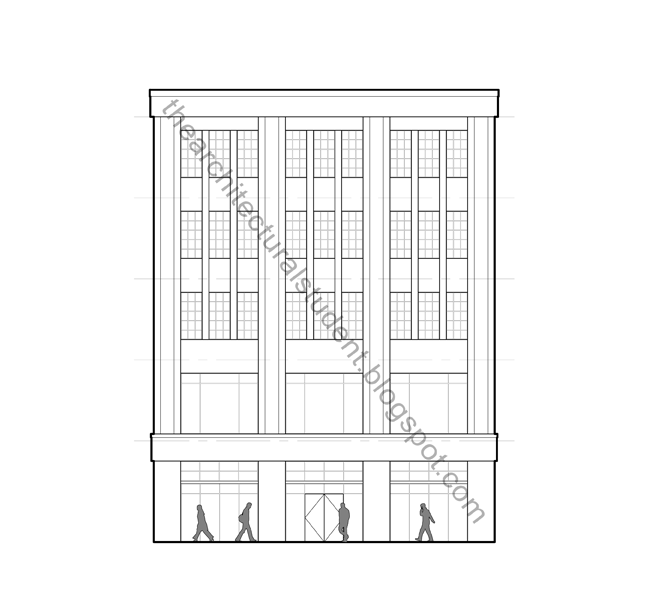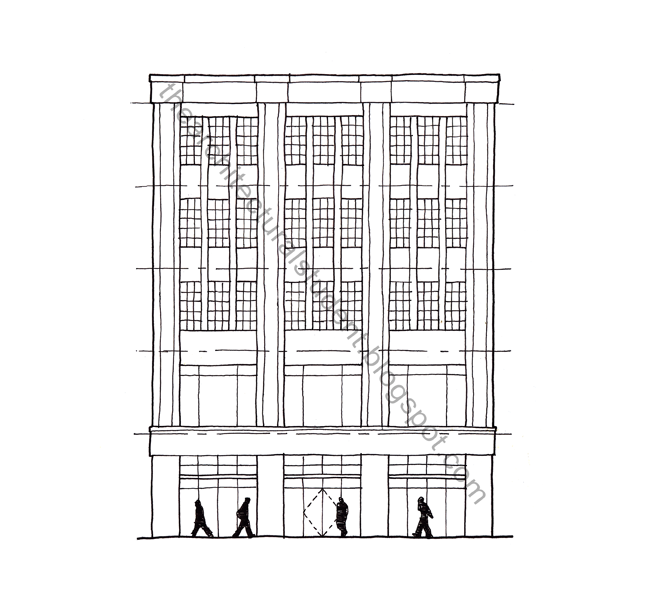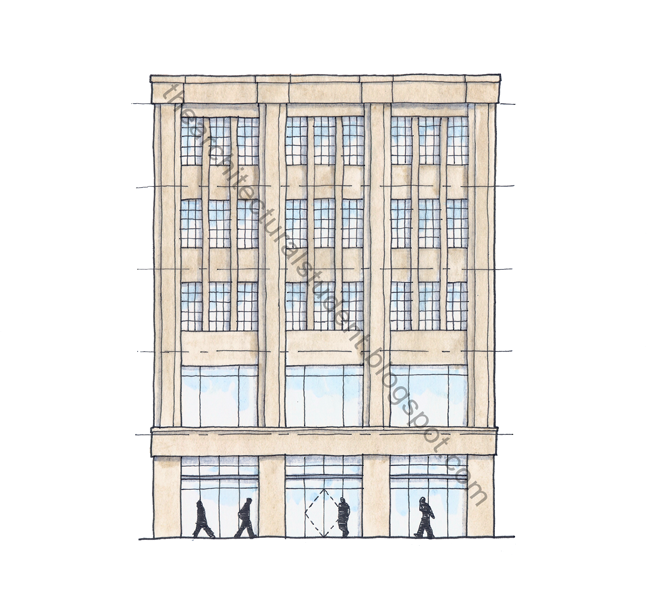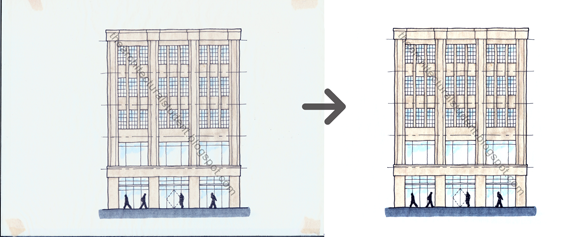 |
| Hand Rendered Elevation |
Since a studio or professional project involves the creation of scale plans in whichever program you use, you can use these primarily plans to create rough elevations of your proposed building. These rough elevations can also be used later to create final elevations of your building or if you have them already done, use them to create hand rendered elevations.
You will need
- CAD Print (preferably printed to scale)
- Drafting Tape or Drafting Dots
- Vellum or Trace (white)
- Pens (at least 3 thicknesses) or Pencils (at least two lead types)
- Markers or colored pencils
- Scanner
 |
| Original CAD Printout |
Print your elevation to be rendered to scale using whichever program you use. Take the print and put trace paper or vellum over it to trace the lines. You can have all the windows or doors already placed in the elevation or use it as a background to help you play around with your design. If you don't have a scaled drawing, either start drafting them, or freehand a sketch of them will work just as well.
At this point you should be familiar with creating an elevation from plans or from your head. If you are still starting to conceptualize your building's exterior, create a rough version of your facade either on the computer or on the paper. It is good to put in floor heights (dashed) with heights, as well as any defining features you want to implement so anyone reviewing them with you can see your thinking. This will help you formulate window openings on the facade. Be sure not to forget how thick your floors will end up being so don't make your windows too tall, unless of course, that is your intention.
Tracing
 |
| CAD Hand Tracing (on trace) |
When tracing or sketching you should ideally use 3 different pen thicknesses or at least 2 different pencil leads (click here for pencil lead help) depending on the detail you are going for, varying pressure on the pen or pencil will also give you different line thicknesses. Use different line weights to highlight the fenestration, overhangs, etc. within your building. When going sketchy, show your style, if you are going hard-lined, make sure your line weights look right. Going back over them again can be a waste of time. When using pen, use an edge that is made for pen, which will help with smudging.
For this drawing I used Pelikan Techno Liner Pens which are fairly cheap, come 8 in a pack (0.1mm - 0.8mm) and are great for sketching. I use them a lot when working on studio stuff. I used 0.1mm, 0.2mm, and a 0.5mm for this trace, however I think they don't make them anymore. I would instead recommend getting a set of Prismacolor Premiere Fine Line Markers as a bit of a higher quality substitute. You can use Pigma Micron Ink Pens as well. I find they work better on ink or drawing paper rather than on vellum or trace. I also used white trace paper which is much cheaper than velum and comes in 20 or 50 yard rolls. If you are new to architecture, you will use trace more than you could possible imagine.
Coloring
 |
| Pen trace with shading on front and color on back |
In this example I used Prismacolor Premier Double Ended Art Markers. Always take out the colors you might want to use and try them together on a piece of scrap of the same type of paper to see what they look like. Of course you can just shade the elevation rather than color it and call it done. When using marker, you can create the shading by making the colors darker under overhangs. Another way is to shade the elevation on the front using a gray marker and use the color on the back, this way the color and shading won't run together and help to define your facade. If you are using colored pencil you can blend the shading with the color on the back of the paper without and issue since colored pencil is actually wax, just remember you can't erase it too well. I suggest adding the shading last when using pencil, do whichever with marker, just be sure to let it dry before you move onto another color or they will smudge together. It is up to you to decide what you want the final product to be, so experiment.
 |
| CAD Sketch Layered over Color Trace |
 |
| Layers: CAD Trace, Shadows, and Color |
When coloring, I recommend coloring in the direction of the material. What I mean is that if your building is brick, color horizontally using the small tip in order to get the feel of brick. Do the same thing for which ever material you are using. While using marker, having a tissue or paper towel handy will help you blot up any pools of color left when you lift up the marker. You can also plan ahead and pick up the marker in a place where you want it darker. Ending where there is a shadow will also help you define the building facade further. Again, this is all about your personal style, so play around and figure out what works best for you.
Scanning
For whatever reason a scan looks even better than the original. I only have a 9x12 inch scanner yet I get great results blowing up the renders to triple their original size. The trick there is to scan the original at 150% or 200% the size which will get you a very clear scan.
Once you have it scanned, play with it in Photoshop a bit to get the colors right or you can even leave it alone. I tend to edit my scans so the background becomes white. Be sure to save any changes to a new edited file so you always have the original scan to edit if you need to. Below is the before and after of my work. You can see the tape holding the layers of trace together in the scan keeping them aligned.
 |
| Original scanned elevation and after being Photoshop |
I hope this post was helpful. It took me a while to figure it all out myself. If you have any comments, questions, or additional tips, feel free to comment below or send me an e-mail.
More Tutorials
You can also use pencil to create elevations. If you are new to the architecture field and are interested in knowing more about pencils, their different leads and types, check our the Architectural Student's Tutorial on Pencils and Leads. If you are interested in learning more about drafting techniques, please see our Hand Drafting Tutorial.
No comments:
Post a Comment